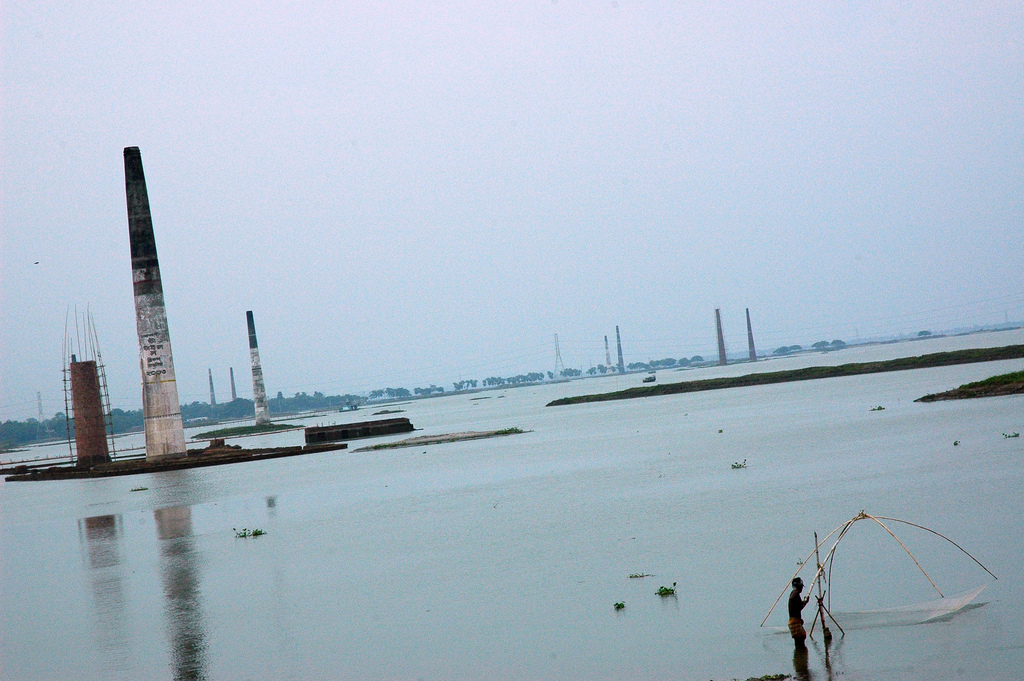Pollution in large rapidly developing cities is a major problem responsible for many premature deaths and serious illnesses, especially for women and children. Pollution has been named ‘the silent killer of millions in poor countries’ by the Global Alliance on Health and Pollution.
The combination of high population numbers, insanitary conditions, poorly regulated industrial discharges and untreated domestic effluents has resulted in highly polluted city rivers which pose a significant threat to people using the river water, groundwater and associated water supply systems. Bangladesh’s Turag-Balu River system in central Dhaka is no exception, with over 30,000 factories discharging waste into the river system and 12 million people contributing waste with minimal treatment, as well as agricultural pollution from upstream areas.
The Turag originates from the Bangshi River, the latter an important tributary of the Dhaleshwari River, and flows through Gazipur and joins the Buriganga River at Mirpur in Dhaka District. The Turag receives a huge waste load of industrial effluent from Gazipur and the Tongi industrial area in addition to domestic waste from numerous sources along its banks. The industrial and municipal wastes are the major sources of pollution due to growing industrial development and the poor state of the sewerage and sanitation system, not only around the Turag but also throughout Dhaka City.
A new study of the Turag-Balu River system is currently underway, led by Professor Paul Whitehead from Oxford University and Professor Abed Hossain from the Bangladesh University of Engineering and Technology (BUET). The team are gathering new water quality data and establishing some mathematical models for the river systems, which can then be used to evaluate different pollution reduction measures including effluent treatment, flow augmentation and pollution warning systems.
In order to model water quality it is necessary to first model the hydrology of the system. The hydrology of the Turag-Balu River system is highly complex and special attention needs to be paid to the additional flood flows and runoff coming from the upstream Turag catchment as well as from the Brahmaputra River (Figure 1). The extent of the connection with the upstream rivers, including the Brahmaputra River, is difficult to estimate but we have assumed the transfer of water across to the Turag as shown in Figure 1 and we have estimated this flow transfer system.

Figure 1. Reaches and sub-catchments of the Turag-Balu River system around Dhaka (dry season – left, monsoon season – right). The red arrows indicate the directions.
Figure 1. Reaches and sub-catchments of the Turag-Balu River system around Dhaka (dry season – left, monsoon season – right). The red arrows indicate the directions.
A set of preliminary simulations have been undertaken for the Turag River System with the whole river system spilt into 24 reaches as shown in Figure 1. We have used rainfall data to drive the hydrological model and Figure 2 shows the simulated and observed flows in Reach 10 of the Turag at the confluence with the Tongi Canal. The observed flows match simulated flows but note the observed flow data is only available at certain times of the year in the monsoon period. However, the peak flows and overall dynamics look reasonable, suggesting that the model is a good fit.

Figure 2. Simulated and observed flow in Reach 10 of the Turag Model (located at the confluence with the Tongi Canal) and simulated Nitrate (as N) and Ammonia (as N) concentrations
Figure 2. Simulated and observed flow in Reach 10 of the Turag Model (located at the confluence with the Tongi Canal) and simulated Nitrate (as N) and Ammonia (as N) concentrations.
We have also used the model to simulate levels of nitrate and ammonia in the river. The results show low concentrations in monsoon periods when flows are high and dilute all of the pollution from diffuse runoff and point sources. Much higher concentrations are found in the low flow periods when little dilution occurs.
Once we have further calibrated the model we will investigate future potential change such as the impacts of climate change and socio-economic change on flows and water quality. We will also be able to set up additional models for pathogens and organic pollutants in the river system.

